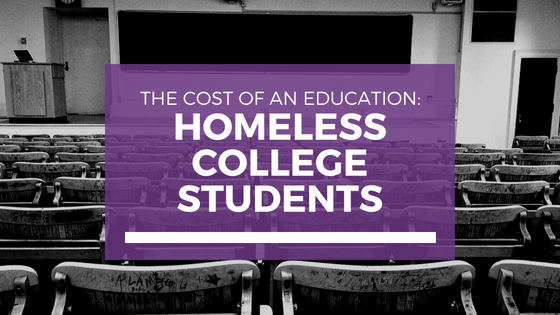
It’s the homeless issue we perhaps talk about least. Students.
By Zack Johnston
What was once a humorous stereotype has become a stark reality for many young people trying to create a positive change for their futures. The starving college student archetype is no laughing matter, as thousands of students across the country struggle with housing and food insecurity.
One in ten California State University students experienced some form of homelessness in 2017, according to a study conducted by the university system.
While some of us had the financial support of our parents to help us get through college, others are struggling to cover the costs on their own while affording food and a place to live. These students can be out on their own for a number of reasons, some of which beyond their control.
Regardless of the reason, these are the students who have to work the hardest to keep their grades up and keep a roof over their head. A combination of rising tuition, cuts in state funds, stagnant wages and insufficient affordable housing has lead to an epidemic of student homelessness.
Students living on their own can apply for financial aid, but depending on the circumstances the package might not even cover a year’s tuition. These student must juggle classes and working part-time, and sometimes full-time, to cover their remaining tuition costs. That doesn’t always leave much for rent, food, gas and school supplies.
Add a couple textbooks and mandatory expenses and you’ve fallen well below the poverty line.
The Department of Housing and Urban Development considers households paying more than 30 percent of income on housing to be “cost burdened.”
Working to afford tuition and the cost of living while focusing on passing classes places an extraordinary, daily burden on these students to the point where some are sleeping in cars, skipping meals, and suffering in their mental health.
The Student Health Center at Saddleback College puts out a mobile food pantry twice a month to combat the campus’ growing food insecurity.
The mobile pantry, organized by supervising physician Dr. Jeanne Caldwell-Harris, services about 250 students per month. The health center also helps students with food stamps applications and helps them secure a PO box if they don’t have a permanent address.
An emergency fund was also set up with the Saddleback College Foundation to help students pay for housing, transportation and groceries.
A 2017 campus survey identified over 1,100 students as homeless, with about 200 of those students sleeping in cars, campgrounds, beaches, under freeways and the surrounding residential areas.
Many of these students, according to Dr. Caldwell-Harris, are in good academic standing, hold down a job and are motivated to improve their quality of life.
But unfortunately maintaining a job and the motivation to succeed doesn’t always cut it. Everyday these students face the challenge of choosing to put the money they have toward food or housing.
In short, the problem is a combination of skyrocketing tuition costs rising too fast for the economy to catch up, and cuts in state funding for higher education. The average cost of a four-year public university has more than doubled over the last 30 years, from about $3,200 per year to almost $10,000.
These tuition hikes are a response to a decrease in state funding for public universities and colleges. In California, the portion of general funds that go to higher education has dropped from 18 percent to 12 percent over the past four decades.
This has lead to a culture of student poverty, living paycheck to paycheck, and accumulating massive amounts of debt. This issue is taking place all over the country and it places huge damper on the growth of the economy.
As the cost of tuition rises, the value of education drops. If changes are not made, the whole system of public higher education could collapse as only the well-off will be able to afford it.
California and the rest of the country must recommit to affordable higher education before too much damage is done, and the students are left out to dry.
Already converting double rooms to triples to increase capacity, some campuses have also begun acting as social service agencies, setting up a patchwork of programs that includes giving students emergency grants for rent payment, and reserving some dorm beds for homeless students. Bills under consideration in the California Legislature aim to increase the supply of student housing, reduce its cost and boost aid. Yet they likely will prove insufficient to solve what experts say is the extreme end of a nationwide student housing crisis. (Source)
The Student Health Center at Saddleback College puts out a mobile food pantry twice a month to combat the campus’ growing food insecurity. The mobile pantry, organized by supervising physician Dr. Jeanne Caldwell-Harris, services about 250 students per month. The health center also helps students with food stamps applications and helps them secure a PO box if they don’t have a permanent address.
An emergency fund was also set up with the Saddleback College Foundation to help students pay for housing, transportation and groceries.
A 2017 campus survey identified over 1,100 students as homeless, with about 200 of those students sleeping in cars, campgrounds, beaches, under freeways and the surrounding residential areas. Many of these students, according to Dr. Caldwell-Harris, are in good academic standing, hold down a job and are motivated to improve their quality of life. But unfortunately maintaining a job and the motivation to succeed doesn’t always cut it. Everyday these students face the challenge of choosing to put the money they have toward food or housing.
In short, the problem is a combination of skyrocketing tuition costs rising too fast for the economy to catch up, and cuts in state funding for higher education. The average cost of a four-year public university has more than doubled over the last 30 years, from about $3,200 per year to almost $10,000.
These tuition hikes are a response to a decrease in state funding for public universities and colleges. In California, the portion of general funds that go to higher education has dropped from 18% to 12% over the past four decades.
This has led to a culture of student poverty, living paycheck to paycheck, and accumulating massive amounts of debt. This issue is taking place all over the country and it places a huge damper on the growth of the economy.
As the cost of tuition rises, the value of education drops. If changes are not made, the whole system of public higher education could collapse as only the well-off will be able to afford it.
California and the rest of the country must recommit to affordable higher education before too much damage is done, and the students are left out to dry.
In the meantime, if you or a college student you know is struggling with homelessness, contact the team at StandUp For Kids – Orange County to find out how we can help. Want to join us in our mission to end youth homelessness? Here’s how you can help.
